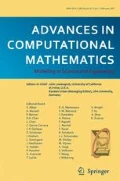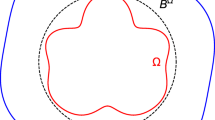Abstract
We consider the approximate solution of axisymmetric biharmonic problems using a boundary-type meshless method, the Method of Fundamental Solutions (MFS) with fixed singularities and boundary collocation. For such problems, the coefficient matrix of the linear system defining the approximate solution has a block circulant structure. This structure is exploited to formulate a matrix decomposition method employing fast Fourier transforms for the efficient solution of the system. The results of several numerical examples are presented.
Similar content being viewed by others
References
I. Altas, J. Erhel and M. Gupta, High accuracy solution of three-dimensional biharmonic equations, Numer. Algorithms 29 (2002) 1–19.
K. Balakrishnan and P.A. Ramachandran, The method of fundamental solutions for linear diffusion–reaction equations, Math. Comput. Modelling 31 (2000) 221–237.
C. Bernardi, G. Coppoletta and Y. Maday, Some spectral approximations of multidimensional fourth order problems, Technical Report R90021, Laboratoire d’Analyse Numérique, Université Pierre et Marie Curie, Paris (1990).
B. Bialecki and G. Fairweather, Matrix decomposition algorithms for separable elliptic boundary value problems in two space dimensions, J. Comput. Appl. Math. 46 (1993) 369–386.
T.A. Cruse, Boundary Element Analysis in Computational Fracture Mechanics (Kluwer Academic, Dordrecht, 1988).
P.J. Davis, Circulant Matrices (Wiley, New York, 1979).
G. Fairweather and A. Karageorghis, The method of fundamental solutions for elliptic boundary value problems, Adv. Comput. Math. 9 (1998) 69–95.
G. Fairweather, A. Karageorghis and P.A. Martin, The method of fundamental solutions for scattering and radiation problems, Engrg. Anal. Boundary Elements 27 (2003) 759–769.
M.A. Golberg and C.S. Chen, Discrete Projection Methods for Integral Equations (Computational Mechanics Publications, Southampton, 1996).
M.A. Golberg and C.S. Chen, The method of fundamental solutions for potential, Helmholtz and diffusion problems, in: Boundary Integral Methods and Mathematical Aspects, ed. M.A. Golberg (WIT Press/Computational Mechanics Publications, Boston, 1999) pp. 103–176.
M.A. Jaswon and G.T. Symm, Integral Equation Methods in Potential Theory and Elastostatics (Academic Press, London, 1977).
A. Karageorghis and G. Fairweather, The method of fundamental solutions for the solution of the biharmonic equation, J. Comput. Phys. 69 (1987) 434–459.
A. Karageorghis and G. Fairweather, The method of fundamental solutions for axisymmetric acoustic scattering and radiation problems, J. Acoust. Soc. Amer. 104 (1988) 3212–3218.
A. Karageorghis and G. Fairweather, The method of fundamental solutions for axisymmetric potential problems, Internat. J. Numer. Methods Engrg. 44 (1999) 1653–1669.
A. Karageorghis and G. Fairweather, The method of fundamental solutions for axisymmetric elasticity problems, Comput. Mech. 25 (2000) 524–532.
M-J. Lai and P. Wenston, Trivariate C1 cubic splines for numerical solution of biharmonic equations, in: Trends in Approximation Theory, eds. K. Kopotun, T. Lyche and M. Neamtu (Vanderbilt Univ. Press, Nashville, TN, 2001) pp. 224–233.
M. Maiti and S.K. Chakrabarti, Integral equation solutions for simply supported polygonal plates, Internat. J. Engrg. Sci. 12 (1974) 793–806.
Numerical Algorithms Group, Library Mark 20, NAG Ltd, Wilkinson House, Jordan Hill Road, Oxford, UK (2001).
D. Redekop and J.C. Thompson, Use of fundamental solutions in the collocation method in axisymmetric elastostatics, Comput. Struct. 17 (1983) 485–490.
J. Ribeiro dos Santos, Équations aux différences finies pour l’équation biharmonique dans l’espace en trois dimensions, C. R. Acad. Sci. Paris Sér. A/B 264 (1967) A291–A293.
V. Ruas, A quadratic finite element method for solving biharmonic problems in Rn, Numer. Math. 52 (1988) 33–43.
V. Ruas and L. Quartapelle, Uncoupled finite element solution of biharmonic problems for vector potentials, Internat. J. Numer. Methods Fluids 11 (1990) 811–822.
Y.S. Smyrlis and A. Karageorghis, Some aspects of the method of fundamental solutions for certain harmonic problems, J. Sci. Comput. 16 (2001) 341–371.
Y.S. Smyrlis and A. Karageorghis, A matrix decomposition MFS algorithm for axisymmetric potential problems, Engrg. Anal. Boundary Elements, to appear.
Y.S. Smyrlis and A. Karageorghis, Numerical analysis of the MFS for certain harmonic problems, Technical Report TR/04/2003, Department of Mathematics and Statistics, University of Cyprus (2003).
Author information
Authors and Affiliations
Corresponding author
Additional information
Communicated by Z. Wu and B.Y.C. Hon
AMS subject classification
65N38, 65F30, 65T50, 65Y99
Rights and permissions
About this article
Cite this article
Fairweather, G., Karageorghis, A. & Smyrlis, YS. A matrix decomposition MFS algorithm for axisymmetric biharmonic problems. Adv Comput Math 23, 55–71 (2005). https://doi.org/10.1007/s10444-004-1808-6
Received:
Accepted:
Issue Date:
DOI: https://doi.org/10.1007/s10444-004-1808-6




